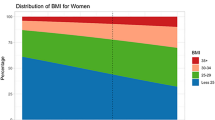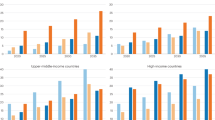Abstract
Background/objectives:
In most populations the prevalence of obesity is greater in women than in men; however, the magnitude of the difference between the sexes varies significantly by country. We considered the role of gender inequality in explaining these disparities.
Subjects/methods:
We undertook an ecological analysis of internationally comparable obesity prevalence data to examine the association between indicators of gender inequality and the differences between men and women in obesity prevalence. Gender inequality was assessed using three measures: the Gender Inequality Index, the Global Gender Gap Index and the Social Institutions and Gender Index. We fitted multiple regression models to examine the association.
Results:
We found that the prevalence of obesity across countries shows gendered patterning with greater prevalence and greater heterogeneity in women than in men (P<0.001). We also found that two of three measures of gender inequality were significantly associated with the sex differences in obesity prevalence across countries.
Conclusions:
The patterning of obesity across countries is gendered. However, the association between global measures of gender inequality and the sex gap in obesity is dependent on the measure used. Further research is needed to investigate the mechanisms that underpin the gendered nature of obesity prevalence.
This is a preview of subscription content, access via your institution
Access options
Subscribe to this journal
Receive 12 print issues and online access
$259.00 per year
only $21.58 per issue
Buy this article
- Purchase on Springer Link
- Instant access to full article PDF
Prices may be subject to local taxes which are calculated during checkout


Similar content being viewed by others
References
Finucane MM, Stevens GA, Cowan MJ, Danaei G, Lin JK, Paciorek CJ et al. National, regional, and global trends in body-mass index since 1980: systematic analysis of health examination surveys and epidemiological studies with 960 country-years and 91 million participants. Lancet 2011; 377: 557–567.
WHO Global InfoBase: Data for saving lives 2010 Available from https://apps.who.int/infobase/Index.aspx.
Brooks R, Maklakov A . Sex differences in obesity associated with total fertility rate. PLoS ONE 2010; 5: 1–4.
Newby PK, Dickman PW, Adami HO, Wolk A . Early anthropometric measures and reproductive factors as predictors of body mass index and obesity among older women. Int J Obesity 2005; 29: 1084–1092.
Viner RM, Ozer EM, Denny S, Marmot M, Resnick M, Fatusi A et al. Adolescence and the social determinants of health. Lancet 2012; 379: 1641–1652.
Foresight. Tackling Obesities: Future Choices. Great Britain: Government Office for Science: Great Britain, 2007.
Friel S, Chopra M, Satcher D . Unequal weight: equity oriented policy responses to the global obesity epidemic. Br Med J 2007; 335: 1241–1243.
Poston IIWSC, Foreyt JP . Obesity is an environmental issue. Atherosclerosis 1999; 146: 201–209.
Wang Y, Wang X, Kong Y, Zhang JH, Zeng Q . The great Chinese famine leads to shorter and overweight females in Chongqing Chinese population after 50 years. Obesity 2010; 18: 588–592.
Case A, Menendez A . Sex differences in obesity rates in poor countries: evidence from South Africa. Econ Hum Biol 2009; 7: 271–282.
Bull F, Chey TS, Bergman P, Hipp D . The international prevalence study on physical activity: Results from 20 countries. Int J Behav Nutr Phys Act 2009; 6: 21.
Owen CG, Nightingale CM, Rudnicka AR, Cook DG, Ekelund U, Whincup PH . Ethnic and gender differences in physical activity levels among 9-10-year-old children of white European, South Asian and African-Caribbean origin: the Child Heart Health Study in England (CHASE Study). Int J Epidemiol 2009; 38: 1082–1093.
McLaren L . Socioeconomic status and obesity. Epidemiol Rev 2007; 29: 29–48.
Monteiro CA, Moura EC, Conde WL, Popkin BM . Socioeconomic status and obesity in adult populations of developing countries: a review. Bull World Health Organ 2004; 82: 940–946.
Wells JCK, Marphatia AA, Cole TJ, McCoy D . Associations of economic and gender inequality with global obesity prevalence: understanding the female excess. Soc Sci Med. 2012; 75: 482–490.
Batnitzky A . Obesity and household roles: gender and social class in Morocco. Sociol Health Illn 2008; 30: 445–462.
Yount KM, Li L . Domestic violence and obesity in Egyptian women. J Biosoc Sci 2011; 43: 85–99.
Murnen SK, Smolak L . Femininity, masculinity, and disordered eating: a meta-analytic review. Int J Eat Disord 1997; 22: 231–242.
Chaiken S, Pliner P . Women, but not men, are what they eat—the effect of meal size and gender on perceived femininity and masculinity. Pers Soc Psychol B 1987; 13: 166–176.
Hsu LKG . The gender gap in eating disorders—why are the eating disorders more common among women. Clin Psychol Rev 1989; 9: 393–407.
Ridgers ND, Graves LE, Foweather L, Stratton G . Examining influences on boy's and girls' physical activity patterns: the A-CLASS project. Pediatr Exerc Sci 2010; 22: 638–650.
Trost SG, Pate RR, Sallis JF, Freedson PS, Taylor WC, Dowda M et al. Age and gender differences in objectively measured physical activity in youth. Med Sci Sports Exerc 2002; 34: 350–355.
Krieger N . Genders, sexes, and health: what are the connections—and why does it matter? Int J Epidemiol 2003; 32: 652–657.
Sen G, Östlin P, George A . Unequal, unfair, ineffective and inefficient. Gender Inequity in Health: why it exists and how we can change it. WHO Commission on Social Determinants of Health 2007; 3: 1–12.
Pliner P, Chaiken S . Eating, social motives, and self-presentation in women and men. J Exp Soc Psychol 1990; 26: 240–254.
Mabry RM, Reeves MM, Eakin EG, Owen N . Evidence of physical activity participation among men and women in the countries of the Gulf cooperation council: a review. Obes Rev 2010; 11: 457–464.
Kimmel MS . The Gendered Society, Vol. xii. Oxford University Press: New York, 2000, p 315.
Permanyer I . Are UNDP indices appropriate to capture gender inequalities in Europe? Soc Indic Res 2013; 110: 927–950.
Branisa B, Klasen S, Ziegler M . New measures of gender inequality: The social institutions and gender index (SIGI) and its subindices. Courant Research Centre: Poverty, Equity and Growth-Discussion Papers, 2009, No. 10.
Klugman J . Human Development Report 2010. The Real Wealth of Nations: Pathways to Human Development. Palgrave Macmillan: New York, 2010.
Haussmann R Tyson LD Zahidi S (eds). The Global Gender Gap Report 2010. World Economic Forum: Geneva, 2010.
Surveillance of chronic disease risk factors: country-level data and comparable estimates (SuRF reports; 2): World Health Organization; available from https://apps.who.int/infobase/Publicfiles/SuRF2.pdf 2005.
WHO Global Infobase FAQ Where do comparable estimates come from? Available from https://apps.who.int/infobase/Support.aspx.
Human Development Report 2010 United Nations Development Program; 2010. Available from http://hdr.undp.org/en/.
WHO Global Database on Body Mass Index. Available from: http://apps.who.int/bmi/index.jsp.
World Bank Group World Development Indicators 2009. World Bank Publications: Washington, DC, 2009.
Regidor E . Measures of health inequalities: part 2. J Epidemiol Commun H 2004; 58: 900–903.
Kutner MH, Nachtsheim CJ, Neter J, Li W . Applied Linear Statistical Models, 5th edn. McGraw-Hill: Boston, 2005.
Quinn N . Anthropological studies on women's status. Ann Rev Anthropol 1977; 6: 181–225.
Fürst E Cooking and femininity. Women's Stud Int Forum 1997; 20: 441–449.
Bordo S . The body and the reproduction of femininity. Conboy K, Medina N, Stanbury S (eds). Writing on the Body: Female Embodiment and Feminist Theory. In: Columbia University Press: New York, 1997, pp 90–110.
Purdy L . Women's reproductive autonomy: medicalisation and beyond. J Med Ethics 2006; 32: 287–291.
Pickett KE, Kelly S, Brunner E, Lobstein T, Wilkinson RG . Wider income gaps, wider waistbands? An ecological study of obesity and income inequality. J Epidemiol Community Health 2005; 59: 670–674.
. 1st American Marmot MG . The Status Syndrome: How Social Standing Affects our Health and Longevity. 1st American edn, Times Books: New York, 2004, p 319.
Moss NE . Gender equity and socioeconomic inequality: a framework for the patterning of women's health. Soc Sci Med 2002; 54: 649–661.ss
Egger G, Swinburn B . An ‘ecological’ approach to the obesity pandemic. BMJ 1997; 315: 477–480.
Law C, Power C, Graham H, Merrick D . Obesity and health inequalities. Obes Rev 2007; 8: 19–22.
Lear SA, Kohli S, Bondy GP, Tchernof A, Sniderman AD . Ethnic variation in fat and lean body mass and the association with insulin resistance. J Clin Endocrinol Metab. 2009; 94: 4696–4702.
Acknowledgements
We thank David Macleod and Dr. George B. Ploubidis for advice on the statistical aspects of the analysis. We also thank Professors Chris Frost and David Leon for their input on an earlier version of the manuscript.
Author information
Authors and Affiliations
Corresponding author
Ethics declarations
Competing interests
The authors declare no conflict of interest.
Additional information
Supplementary Information accompanies this paper on European Journal of Clinical Nutrition website
Supplementary information
Rights and permissions
About this article
Cite this article
Garawi, F., Devries, K., Thorogood, N. et al. Global differences between women and men in the prevalence of obesity: is there an association with gender inequality?. Eur J Clin Nutr 68, 1101–1106 (2014). https://doi.org/10.1038/ejcn.2014.86
Received:
Revised:
Accepted:
Published:
Issue Date:
DOI: https://doi.org/10.1038/ejcn.2014.86
This article is cited by
-
Explaining gender inequalities in overweight people: a Blinder-Oaxaca decomposition analysis in northern Sweden
International Journal for Equity in Health (2023)
-
Prevalence and gender disparities of type 2 diabetes mellitus and obesity in Esmeraldas, Ecuador: a population-based survey in a hard-to-reach setting
International Journal for Equity in Health (2023)
-
The effect of interactions between BMI and sustained depressive symptoms on knee osteoarthritis over 4 years: data from the osteoarthritis initiative
BMC Musculoskeletal Disorders (2023)
-
Association between obesity and common mental disorders in women: a population-based study in Southern Brazil
Social Psychiatry and Psychiatric Epidemiology (2023)
-
Burden of knee osteoarthritis in the Middle East and North Africa (MENA): an epidemiological analysis from 1990 to 2019
Archives of Orthopaedic and Trauma Surgery (2023)



